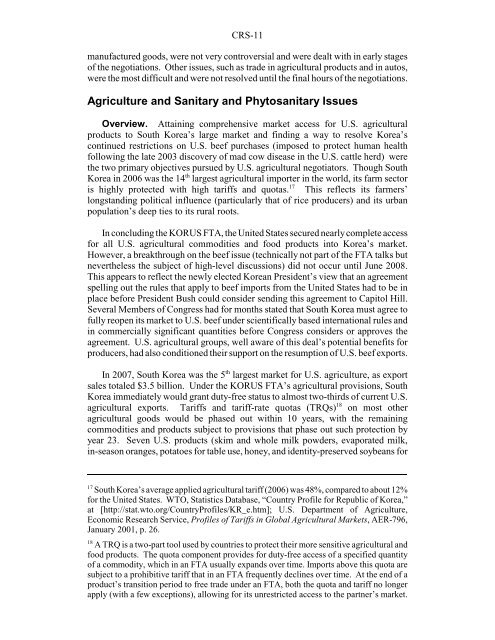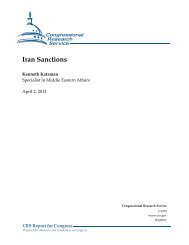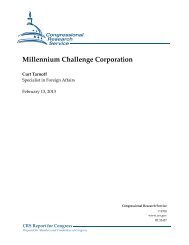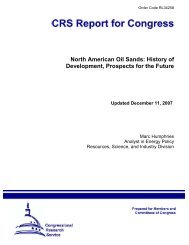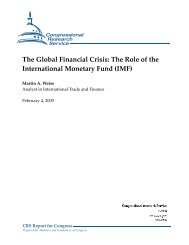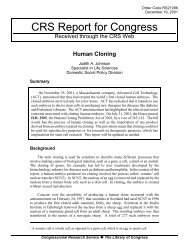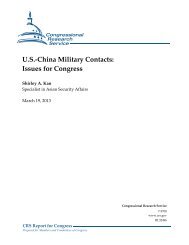The Proposed U.S.-South Korea Free Trade Agreement (KORUS ...
The Proposed U.S.-South Korea Free Trade Agreement (KORUS ...
The Proposed U.S.-South Korea Free Trade Agreement (KORUS ...
- TAGS
- korea
- fpc.state.gov
You also want an ePaper? Increase the reach of your titles
YUMPU automatically turns print PDFs into web optimized ePapers that Google loves.
CRS-11<br />
manufactured goods, were not very controversial and were dealt with in early stages<br />
of the negotiations. Other issues, such as trade in agricultural products and in autos,<br />
were the most difficult and were not resolved until the final hours of the negotiations.<br />
Agriculture and Sanitary and Phytosanitary Issues<br />
Overview. Attaining comprehensive market access for U.S. agricultural<br />
products to <strong>South</strong> <strong>Korea</strong>’s large market and finding a way to resolve <strong>Korea</strong>’s<br />
continued restrictions on U.S. beef purchases (imposed to protect human health<br />
following the late 2003 discovery of mad cow disease in the U.S. cattle herd) were<br />
the two primary objectives pursued by U.S. agricultural negotiators. Though <strong>South</strong><br />
<strong>Korea</strong> in 2006 was the 14 th largest agricultural importer in the world, its farm sector<br />
is highly protected with high tariffs and quotas. 17 This reflects its farmers’<br />
longstanding political influence (particularly that of rice producers) and its urban<br />
population’s deep ties to its rural roots.<br />
In concluding the <strong>KORUS</strong> FTA, the United States secured nearly complete access<br />
for all U.S. agricultural commodities and food products into <strong>Korea</strong>’s market.<br />
However, a breakthrough on the beef issue (technically not part of the FTA talks but<br />
nevertheless the subject of high-level discussions) did not occur until June 2008.<br />
This appears to reflect the newly elected <strong>Korea</strong>n President’s view that an agreement<br />
spelling out the rules that apply to beef imports from the United States had to be in<br />
place before President Bush could consider sending this agreement to Capitol Hill.<br />
Several Members of Congress had for months stated that <strong>South</strong> <strong>Korea</strong> must agree to<br />
fully reopen its market to U.S. beef under scientifically based international rules and<br />
in commercially significant quantities before Congress considers or approves the<br />
agreement. U.S. agricultural groups, well aware of this deal’s potential benefits for<br />
producers, had also conditioned their support on the resumption of U.S. beef exports.<br />
In 2007, <strong>South</strong> <strong>Korea</strong> was the 5 th largest market for U.S. agriculture, as export<br />
sales totaled $3.5 billion. Under the <strong>KORUS</strong> FTA’s agricultural provisions, <strong>South</strong><br />
<strong>Korea</strong> immediately would grant duty-free status to almost two-thirds of current U.S.<br />
agricultural exports. Tariffs and tariff-rate quotas (TRQs) 18 on most other<br />
agricultural goods would be phased out within 10 years, with the remaining<br />
commodities and products subject to provisions that phase out such protection by<br />
year 23. Seven U.S. products (skim and whole milk powders, evaporated milk,<br />
in-season oranges, potatoes for table use, honey, and identity-preserved soybeans for<br />
17 <strong>South</strong> <strong>Korea</strong>’s average applied agricultural tariff (2006) was 48%, compared to about 12%<br />
for the United States. WTO, Statistics Database, “Country Profile for Republic of <strong>Korea</strong>,”<br />
at [http://stat.wto.org/CountryProfiles/KR_e.htm]; U.S. Department of Agriculture,<br />
Economic Research Service, Profiles of Tariffs in Global Agricultural Markets, AER-796,<br />
January 2001, p. 26.<br />
18 A TRQ is a two-part tool used by countries to protect their more sensitive agricultural and<br />
food products. <strong>The</strong> quota component provides for duty-free access of a specified quantity<br />
of a commodity, which in an FTA usually expands over time. Imports above this quota are<br />
subject to a prohibitive tariff that in an FTA frequently declines over time. At the end of a<br />
product’s transition period to free trade under an FTA, both the quota and tariff no longer<br />
apply (with a few exceptions), allowing for its unrestricted access to the partner’s market.


